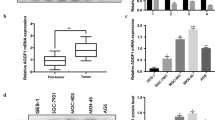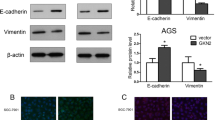Abstract
Purpose
To explore the regulatory relationship between Chloride intracellular channel 1 (CLIC1) and Angiomotin (AMOT)-p130, and reveal the role of AMOT-p130 in gastric cancer (GC).
Methods
Immunohistochemistry was performed to analyze the expression of CLIC1 and AMOT-p130 in GC tissues and adjacent tissues. The expression of AMOT-p130 upon CLIC1 silencing was analyzed using RT-PCR, western blot, and immunofluorescence in GC cells. Transwell and wound-healing assays were performed to detect migration and invasion in GC cells. The changes in EMT-related proteins were detected using western blot.
Results
Our study found that high CLIC1 expression was significantly associated with low AMOT-p130 expression in GC tissues. Silencing CLIC1 expression in MGC-803 cells (MGC-803 CLIC1 KO) and AGS cells (AGS CLIC1 KO) decreased the invasive and migratory abilities of tumor cells, which were induced by the upregulation of AMOT-p130. Subsequently, we demonstrated that AMOT-p130 inhibits the invasive and migratory abilities of GC cells by inhibiting epithelial–mesenchymal transition.
Conclusions
Our study suggests that AMOT-p130 could inhibit epithelial–mesenchymal transition in GC cells. CLIC1 may participate in the metastatic progression of GC by downregulating the expression of AMOT-p130.






Similar content being viewed by others
Change history
16 September 2020
A Correction to this paper has been published: https://doi.org/10.1007/s12094-020-02495-4
References
Bray F, Ferlay J, Soerjomataram I, Siegel RL, Torre LA, Jemal A (2018) Global cancer statistics 2018: GLOBOCAN estimates of incidence and mortality worldwide for 36 cancers in 185 countries. CA: Cancer J Clin 68: 394–424.
Ushio-Fukai M, Xu Y, Zhu J, Hu X, Wang C, Lu D, et al. CLIC1 inhibition attenuates vascular inflammation, oxidative stress, and endothelial injury. PLoS ONE. 2016;11:e0166790.
Wang J-W, Peng S-Y, Li J-T, Wang Y, Zhang Z-P, Cheng Y, et al. Identification of metastasis-associated proteins involved in gallbladder carcinoma metastasis by proteomic analysis and functional exploration of chloride intracellular channel 1. Cancer Lett. 2009;281:71–81.
Ma P-F, Chen J-Q, Wang Z, Liu J-L, Li B-P. Function of chloride intracellular channel 1 in gastric cancer cells. World J Gastroenterol. 2012;18:3070.
Li R-K, Zhang J, Zhang Y-H, Li M-L, Wang M, Tang J-W. Chloride intracellular channel 1 is an important factor in the lymphatic metastasis of hepatocarcinoma. Biomed Pharmacother. 2012;66:167–72.
Chang Y-H, Wu C-C, Chang K-P, Yu J-S, Chang Y-C, Liao P-C. Cell secretome analysis using hollow fiber culture system leads to the discovery of CLIC1 protein as a novel plasma marker for nasopharyngeal carcinoma. J Proteome Res. 2009;8:5465–74.
Feng J, Xu J, Xu Y, Xiong J, Xiao T, Jiang C, et al. CLIC1 promotes the progression of oral squamous cell carcinoma via integrins/ERK pathways. Am J Transl Res. 2019;11:557–71.
Tang H-Y, Beer LA, Chang-Wong T, Hammond R, Gimotty P, Coukos G, et al. A xenograft mouse model coupled with in-depth plasma proteome analysis facilitates identification of novel serum biomarkers for human ovarian cancer. J Proteome Res. 2011;11:678–91.
Troyanovsky B, Levchenko T, Månsson G, Matvijenko O, Holmgren L. Angiomotin: an angiostatin binding protein that regulates endothelial cell migration and tube formation. J Cell Biol. 2001;152:1247–54.
Yang J, Zhang X, Chen Z, Shen Y, Wang F, Wang Y, et al. Angiomotin-p130 inhibits β-catenin stability by competing with Axin for binding to tankyrase in breast cancer. Cell Death Dis. 2019;10:179.
Wang Y, Justilien V, Brennan KI, Jamieson L, Murray NR, Fields AP. PKCiota regulates nuclear YAP1 localization and ovarian cancer tumorigenesis. Oncogene. 2017;36:534–45.
Yi C, Shen Z, Stemmer-Rachamimov A, Dawany N, Troutman S, Showe LC, et al. The p130 Isoform of Angiomotin Is Required for Yap-Mediated Hepatic Epithelial Cell Proliferation and Tumorigenesis. Sci Signal. 2013;6:ra77.
Hong SA, Son MW, Cho J, Jang SH, Lee HJ, Lee JH, et al. Low angiomotin-p130 with concomitant high Yes-associated protein 1 expression is associated with adverse prognosis of advanced gastric cancer. APMIS. 2017;125:996–1006.
Nagtegaal ID, Odze RD, Klimstra D, Paradis V, Rugge M, Schirmacher P, et al. The 2019 WHO classification of tumours of the digestive system. Histopathology. 2020;76:182–8.
Sano T, Aiko T. New Japanese classifications and treatment guidelines for gastric cancer: revision concepts and major revised points. Gastric Cancer. 2011;14:97–100.
Remmele W, Stegner HE. Recommendation for uniform definition of an immunoreactive score (IRS) for immunohistochemical estrogen receptor detection (ER-ICA) in breast cancer tissue. Der Pathologe. 1987;8:138–40.
Peretti M, Angelini M, Savalli N, Florio T, Yuspa SH, Mazzanti M. Chloride channels in cancer: focus on chloride intracellular channel 1 and 4 (CLIC1 AND CLIC4) proteins in tumor development and as novel therapeutic targets. Biochimica et Biophysica Acta (BBA). Biomembranes. 2015;1848:2523–31.
Zhao K, Wang Z, Li X, Liu J-L, Tian L, Chen J-Q. Exosome-mediated transfer of CLIC1 contributes to the vincristine-resistance in gastric cancer. Mol Cell Biochem. 2019;462:97–105.
Li B, Mao Y, Wang Z, Chen Y, Wang Y, Zhai C, et al. CLIC1 Promotes the progression of gastric cancer by regulating the MAPK/AKT pathways. Cell Physiol Biochem. 2018;46:907–24.
Ernkvist M, Birot O, Sinha I, Veitonmaki N, Nystrom S, Aase K, et al. Differential roles of p80- and p130-angiomotin in the switch between migration and stabilization of endothelial cells. Biochim Biophys Acta. 2008;1783:429–37.
Chen Z-L, Yang J, Shen Y-W, Li S-T, Wang X, Lv M, et al. AmotP130 regulates Rho GTPase and decreases breast cancer cell mobility. J Cell Mol Med. 2018;22:2390–403.
Hsu YL, Hung JY, Chou SH, Huang MS, Tsai MJ, Lin YS, et al. Angiomotin decreases lung cancer progression by sequestering oncogenic YAP/TAZ and decreasing Cyr61 expression. Oncogene. 2015;34:4056–68.
Lv M, Li S, Luo C, Zhang X, Shen Y, Sui Y, et al. Angiomotin promotes renal epithelial and carcinoma cell proliferation by retaining the nuclear YAP. Oncotarget. 2016;7:12393–403.
Wang X, Liang Z, Xu X, Li J, Zhu Y, Meng S, et al. miR-148a-3p represses proliferation and EMT by establishing regulatory circuits between ERBB3/AKT2/c-myc and DNMT1 in bladder cancer. Cell Death Dis. 2016;7:e2503.
Nijkamp MM, Span PN, Hoogsteen IJ, van der Kogel AJ, Kaanders JH, Bussink J. Expression of E-cadherin and vimentin correlates with metastasis formation in head and neck squamous cell carcinoma patients. Radiother Oncol. 2011;99:344–8.
Yi Kim D, Kyoon Joo J, Kyu Park Y, Yeob Ryu S, Soo Kim H, Kyun Noh B, et al. E-cadherin expression in early gastric carcinoma and correlation with lymph node metastasis. J Surg Oncol. 2007;96:429–35.
Acknowledgements
The study was supported by the Guangxi Medical and Health Fund-funded Project (No. Z2015526); the Science Foundation for Young Scientists of Guangxi Medical University (No. GXMUYSF201502); the Natural Science Foundation of Guangxi (No. 2016GXNSFAA380180); the Guangxi Medical University College Students Innovation and Entrepreneurship Training Program Project 2019 (No. 201910598091); the National Natural Science Foundation of China (No. 81360370); the Guangxi Scientific Research and Technology Development Project (No. AB18126058) and the Education Department Foundation for Innovation Team of Guangxi Zhuang Autonomous Region.
Author information
Authors and Affiliations
Corresponding authors
Ethics declarations
Conflict of interest
No conflicts of interest.
Ethical approval
The research protocol was approved by the Medical and Human Clinical Trials Committee of the First Affiliated Hospital of Guangxi Medical University. All patients had been received written informed consent.
Informed consent
All patients had been received written informed consent.
Additional information
Publisher's Note
Springer Nature remains neutral with regard to jurisdictional claims in published maps and institutional affiliations.
Rights and permissions
About this article
Cite this article
Qiu, Y., Mao, Yt., Zhu, Jh. et al. CLIC1 knockout inhibits invasion and migration of gastric cancer by upregulating AMOT-p130 expression. Clin Transl Oncol 23, 514–525 (2021). https://doi.org/10.1007/s12094-020-02445-0
Received:
Accepted:
Published:
Issue Date:
DOI: https://doi.org/10.1007/s12094-020-02445-0




